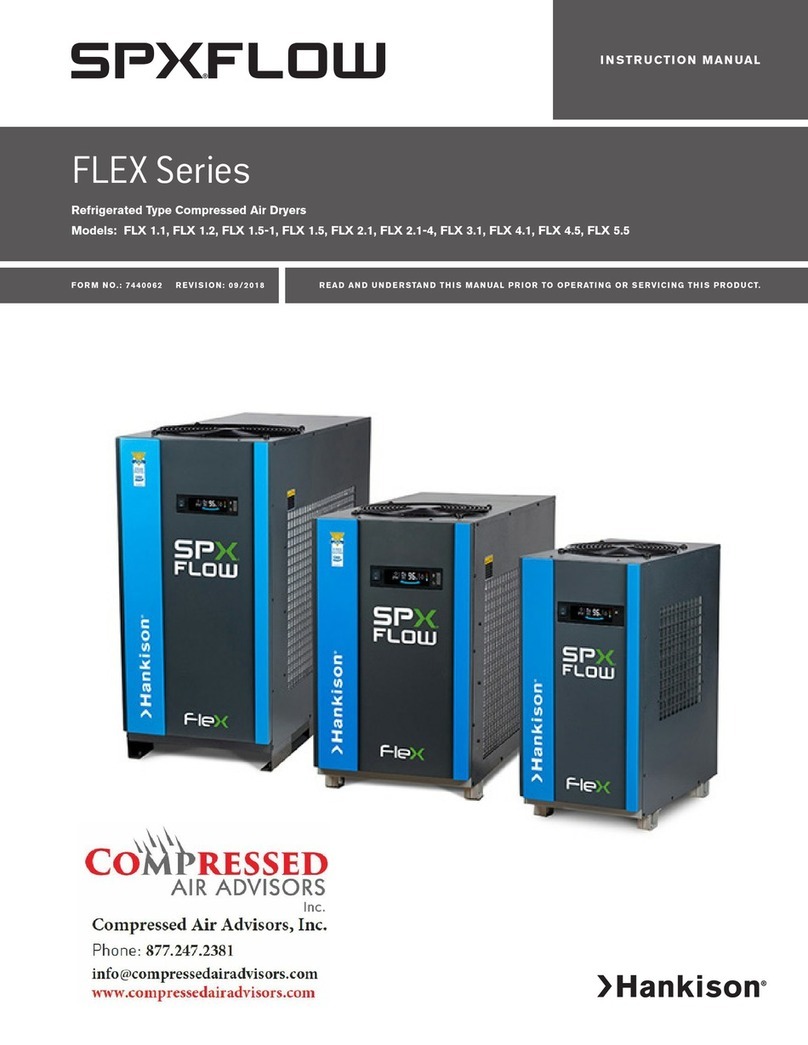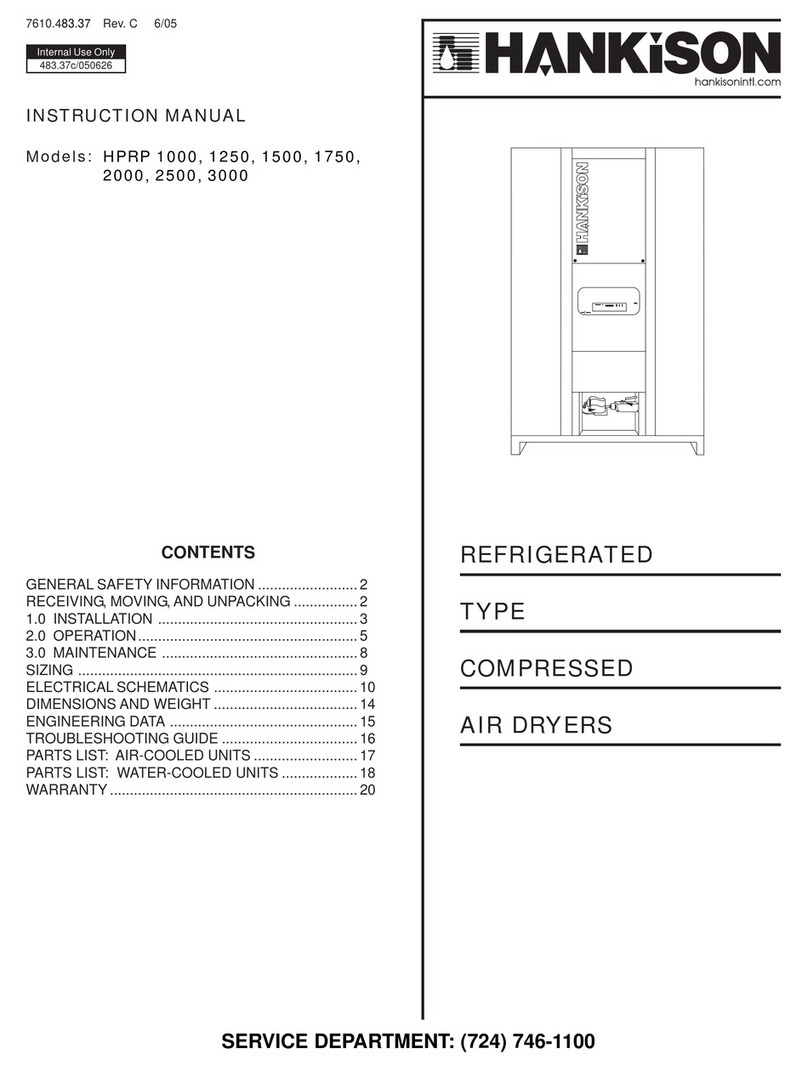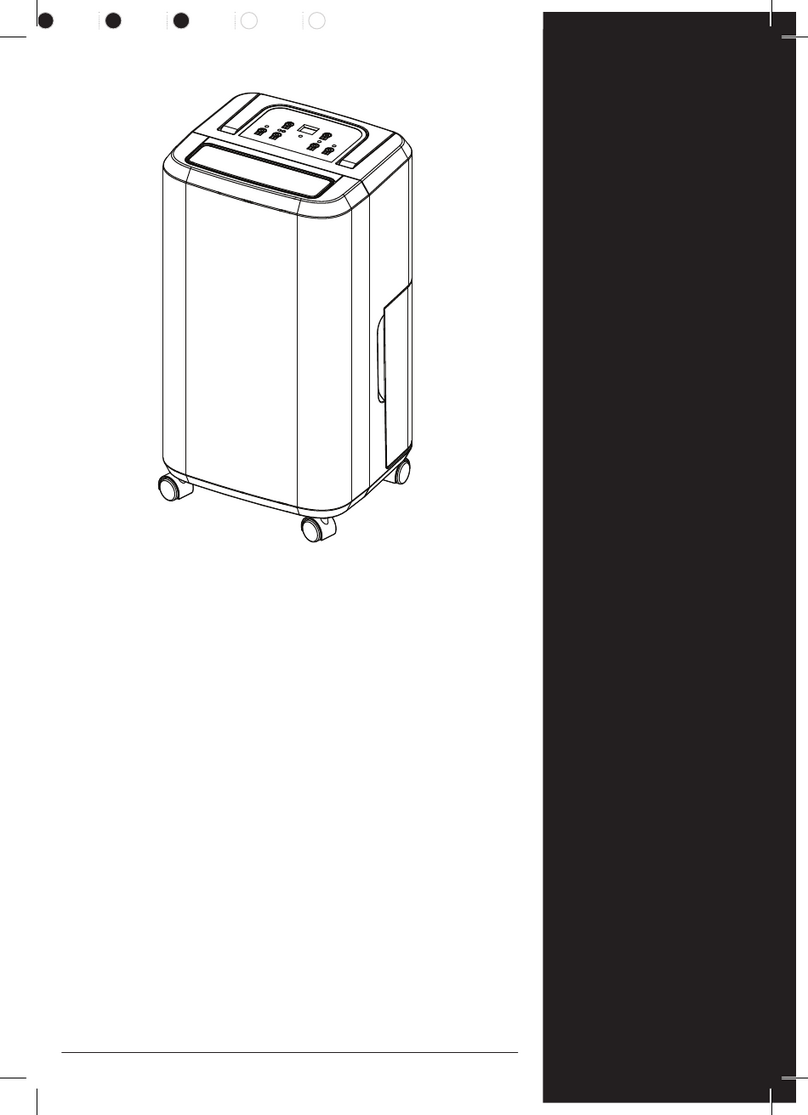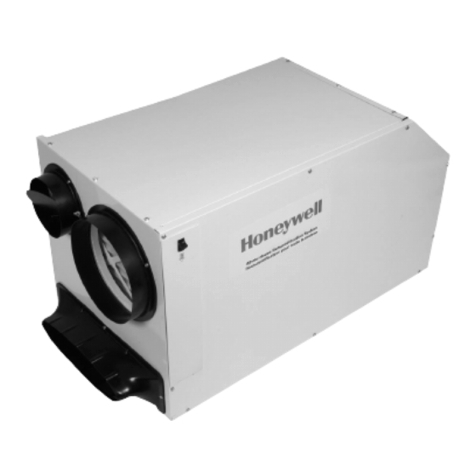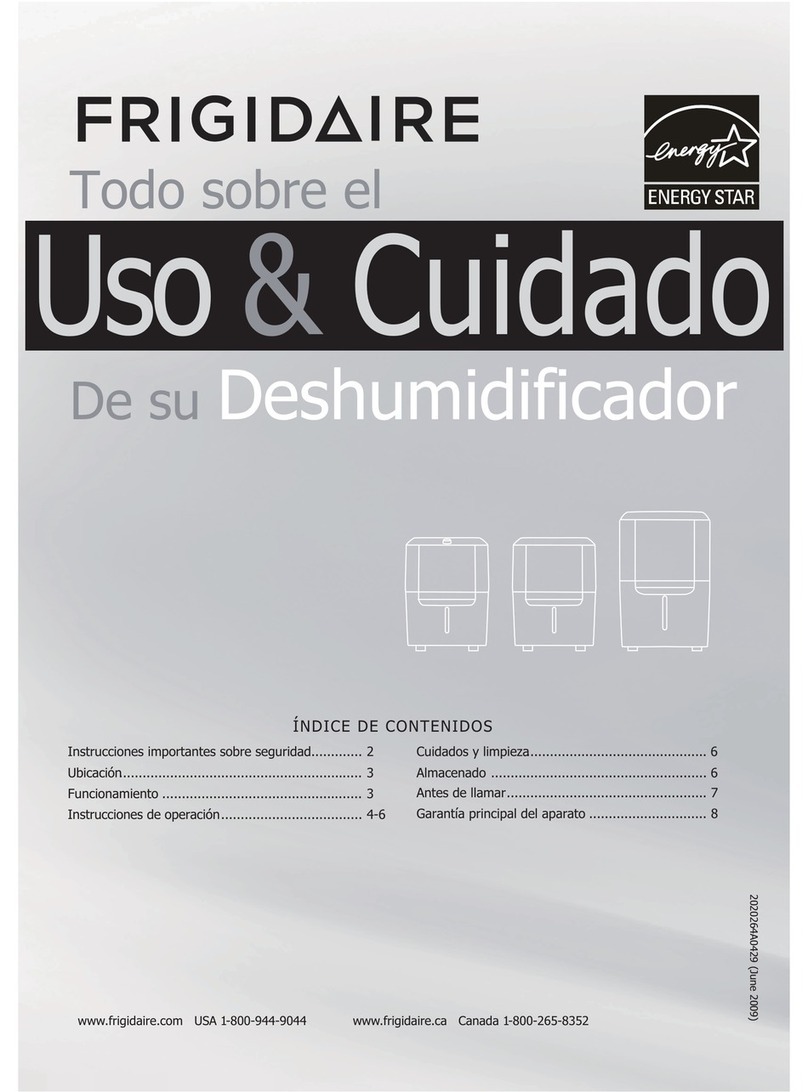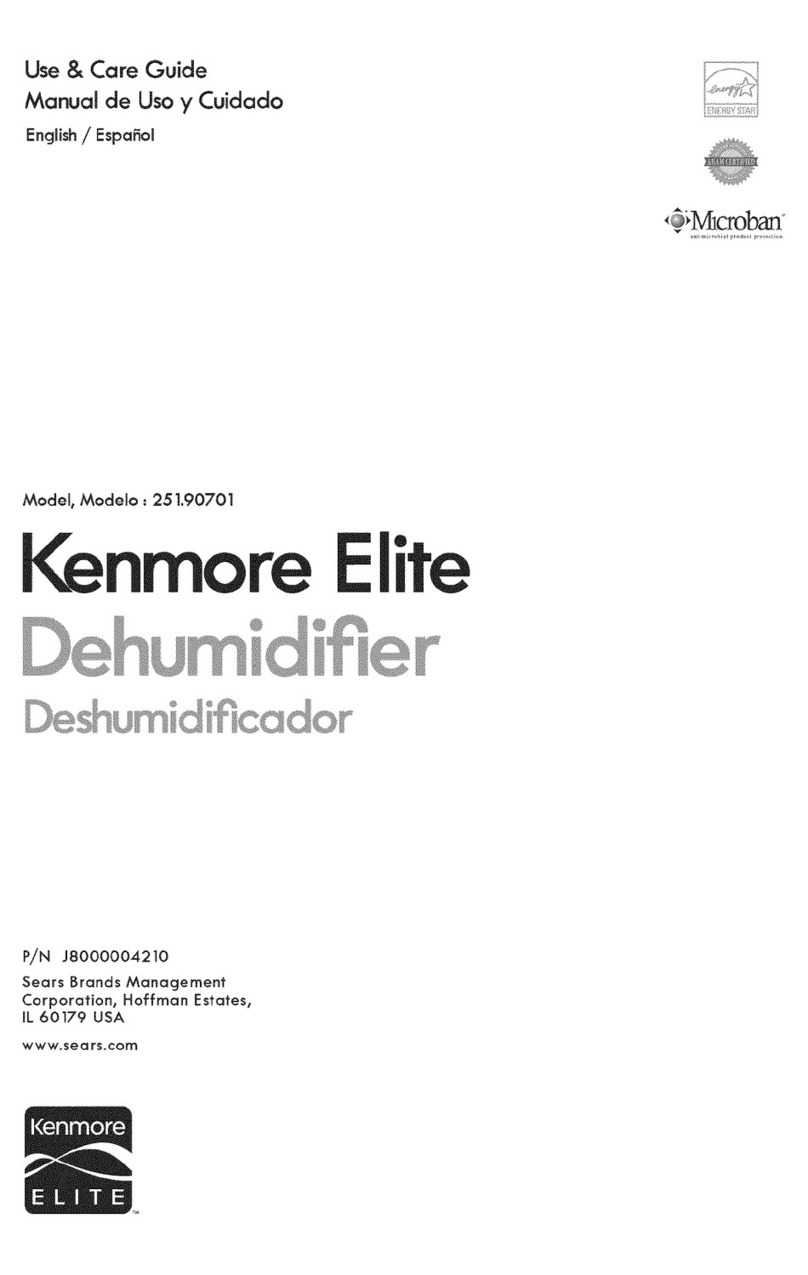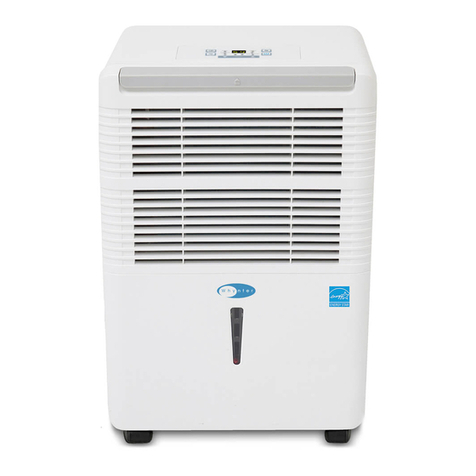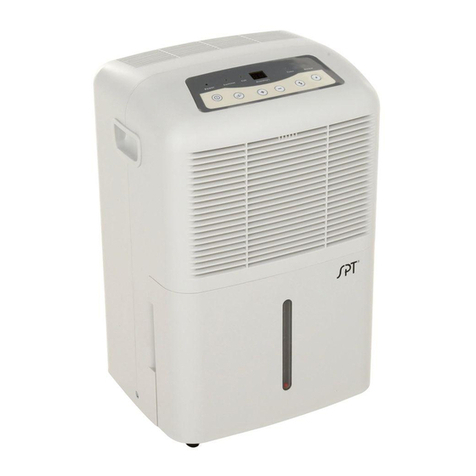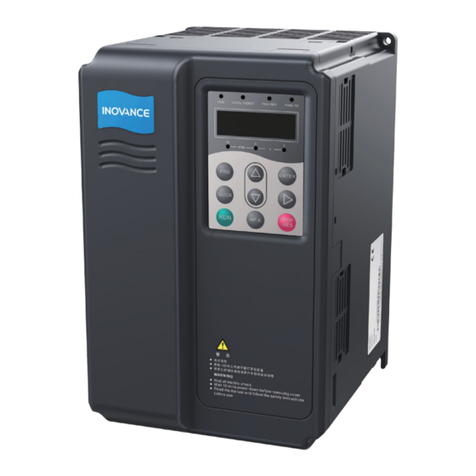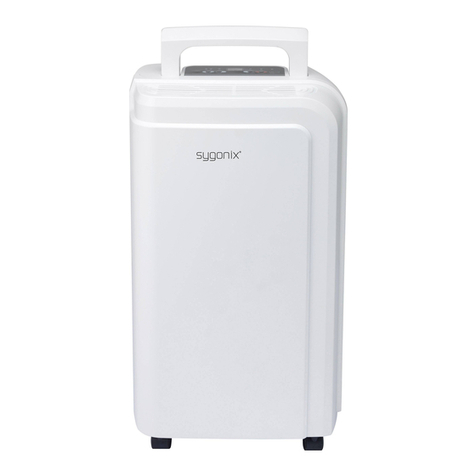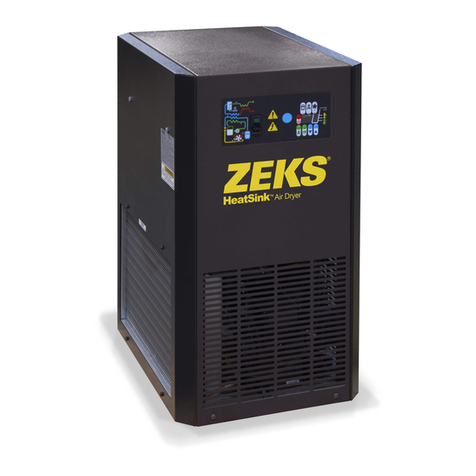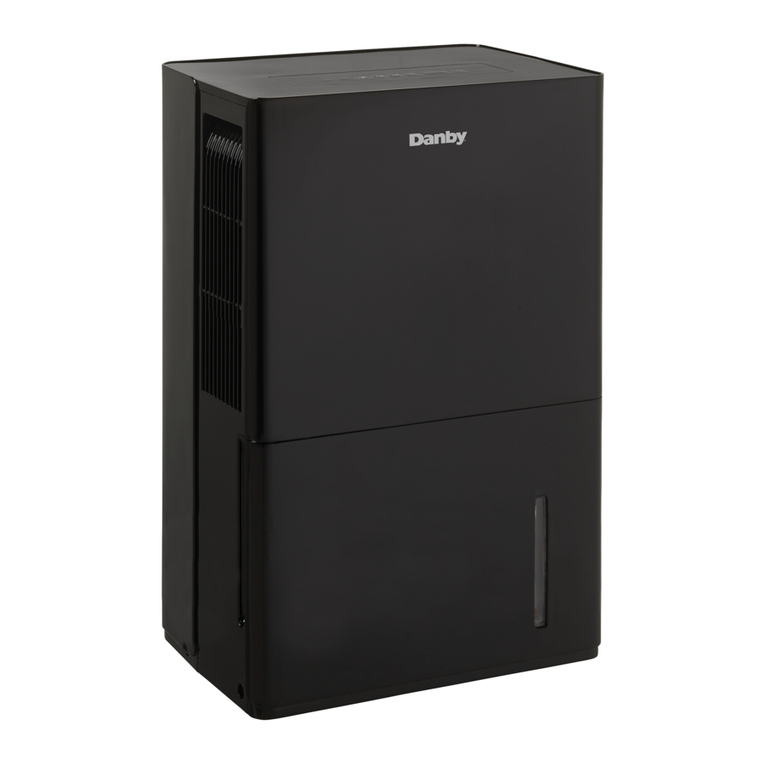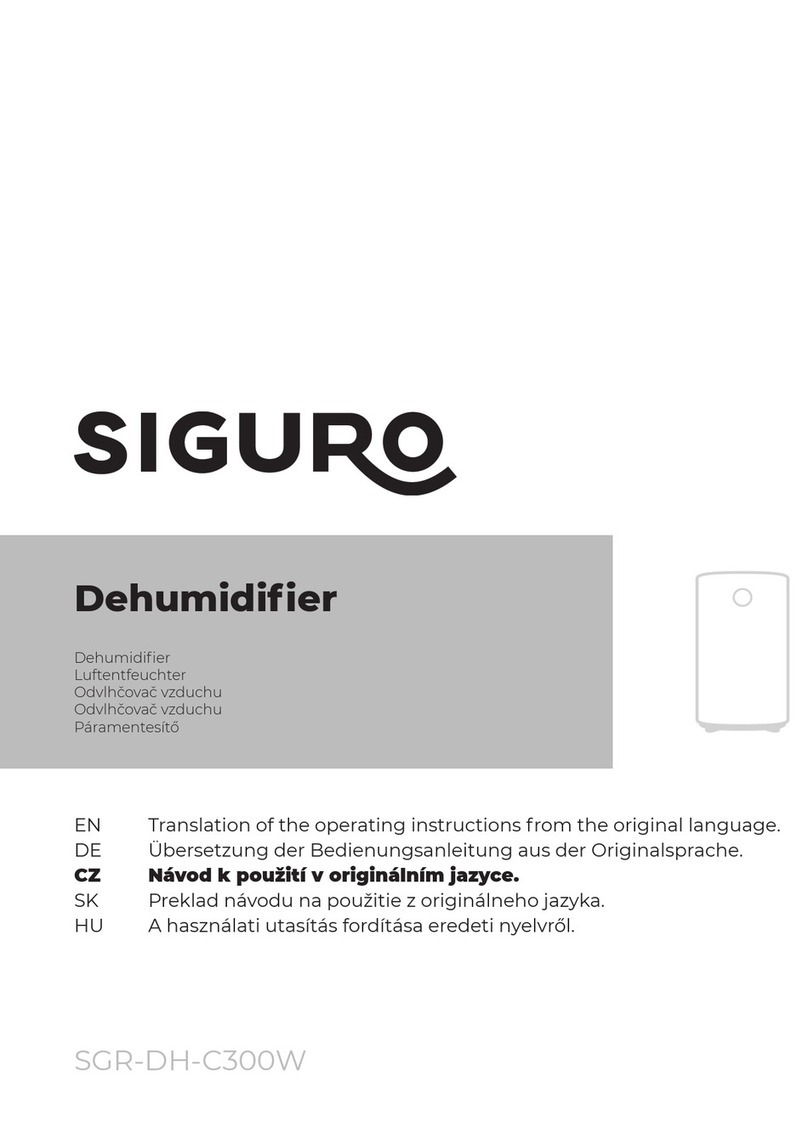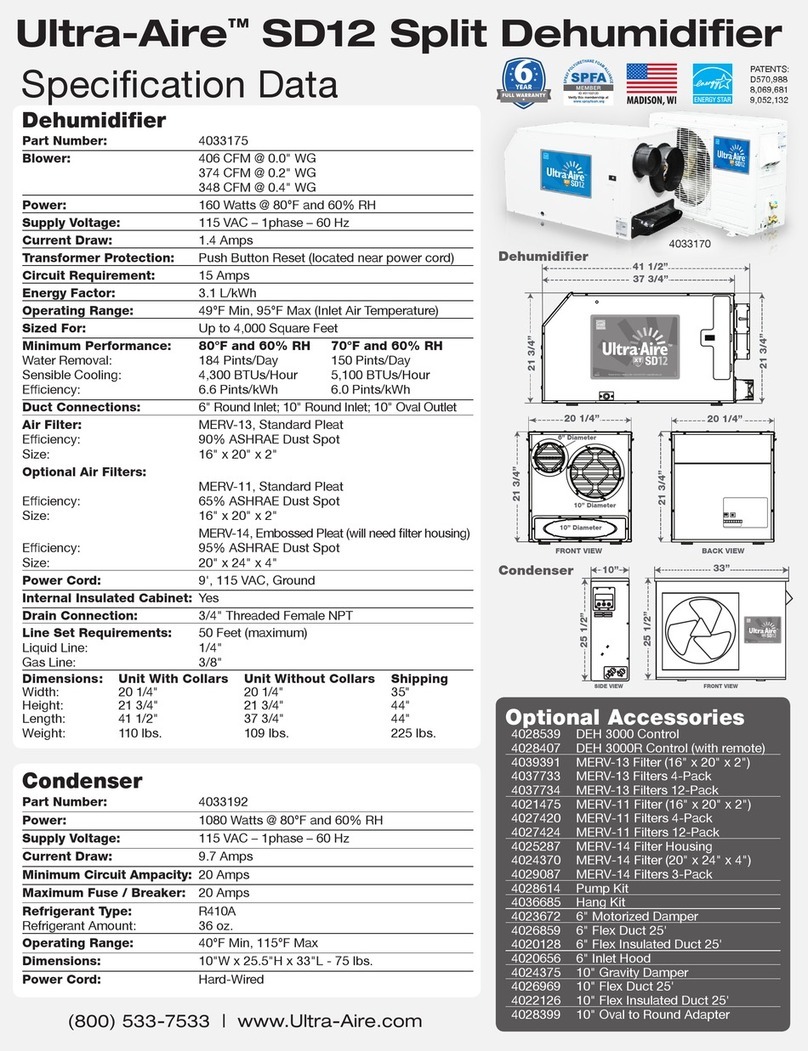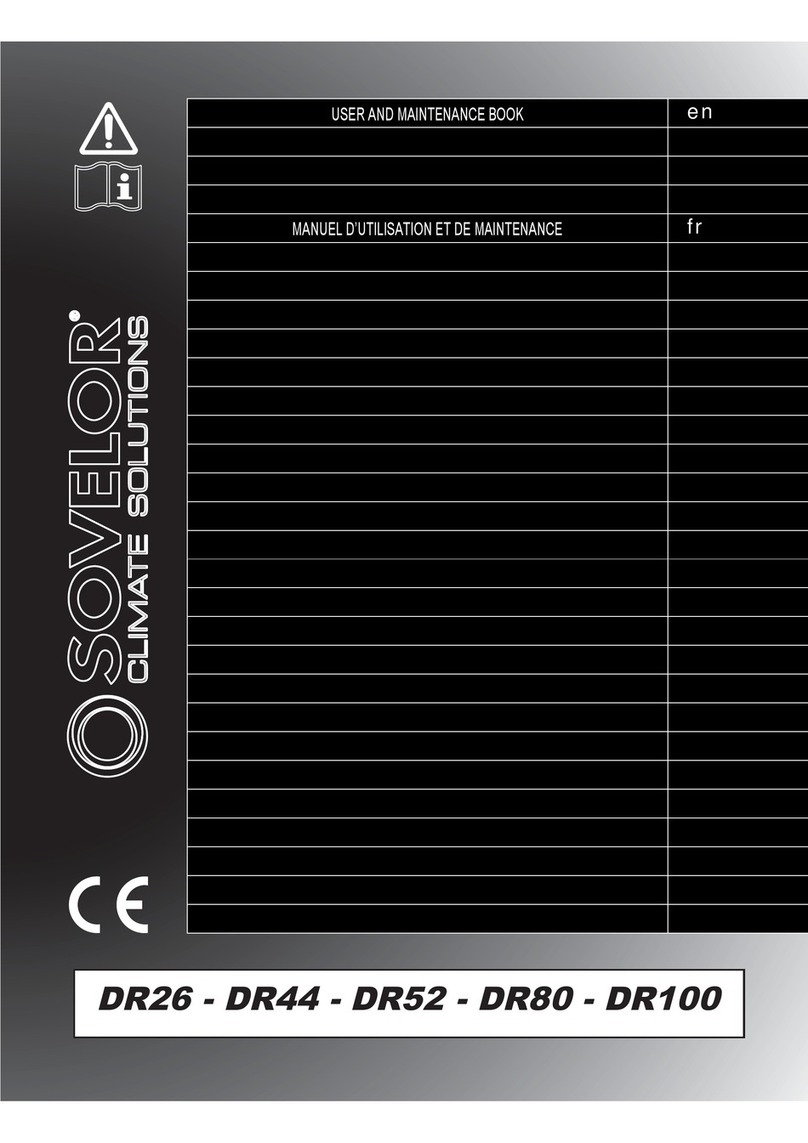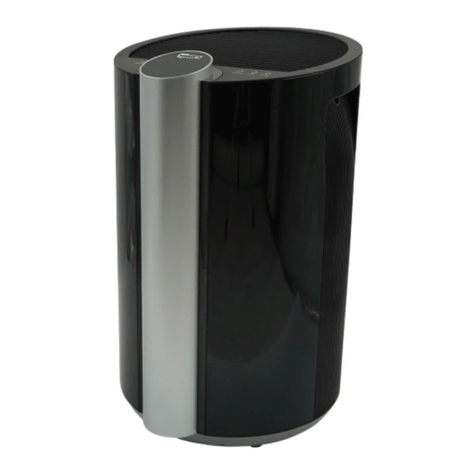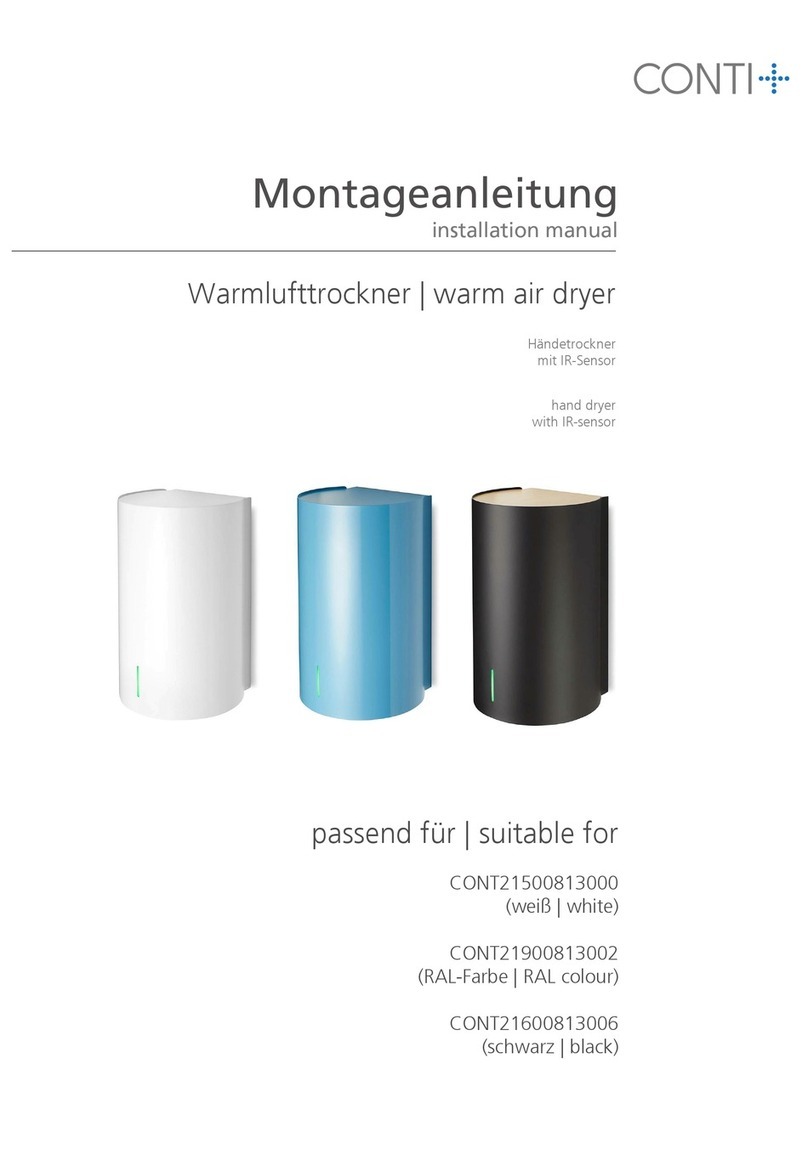HANKISON HPRP 200 User manual

REFRIGERATED
TYPE
COMPRESSED
AIR DRYERS
CONTENTS
GENERAL SAFETY INFORMATION ..................................2
RECEIVING, MOVING, AND UNPACKING .........................2
1.0 INSTALLATION ............................................................3
2.0 OPERATION ................................................................5
3.0 MAINTENANCE ...........................................................8
SIZING ................................................................................8
ENGINEERING DATA .........................................................9
ELECTRICALSCHEMATIC ................................................10
DIMENSIONS / WEIGHTS .................................................12
TROUBLESHOOTING GUIDE............................................13
PARTS LIST ........................................................................14
WARRANTY........................................................................16
INSTRUCTION MANUAL
Models: HPRP 200, 250, 300, 400, 500
7610.483.45 Rev. A 4/05
18-2-675 5th Edition
Internal Use Only
050417
c
SERVICE DEPARTMENT: (724) 746-1100

2
GENERAL SAFETY INFORMATION
1. PRESSURIZED DEVICES:
This equipment is a pressure containing
device.
• Do not exceed maximum operating
pressure as shown on equipment
serial number tag.
• Make sure equipment is depressurized before working
on or disassembling it for service.
2. ELECTRICAL:
This equipment requires electricity to
operate.
• Install equipment in compliance with all
applicable electrical codes.
• Standard equipment is supplied with electrical
enclosures not intended for installation in hazardous
environments.
• Disconnect power supply to equipment when
performing any electrical service work.
3. BREATHING AIR:
• Air treated by this equipment may not
be suitable for breathing without further
purification.
Refer to applicable standards and specifications for the
requirements for breathing quality air.
RECEIVING, MOVING, AND UNPACKING
A. RECEIVING
This shipment has been thoroughly checked, packed and
inspected before leaving our plant. It was received in
good condition by the carrier and was so acknowledged.
Check for Visible Loss or Damage. If this shipment
shows evidence of loss or damage at time of delivery to
you, insist that a notation of this loss or damage be made
on the delivery receipt by the carrier’s agent.
B. UNPACKING
Check for Concealed Loss or Damage. When a
shipment has been delivered to you in apparent good
order, but concealed damage is found upon unpacking,
notify the carrier immediately and insist on his agent
inspecting the shipment. Concealed damage claims are
not our responsibility as our terms are F.O.B. point of
shipment.
C. MOVING
In moving or transporting dryer, do not tip dryer onto its
side.
D. STORAGE/SHUT DOWN
Dryer should not be stored outside (either
packed or unpacked) or exposed to the weather. Damage to
electrical and control components may result.
IMPORTANT: WATER-COOLED UNITS - If unit is shut down
below freezing temperatures, the water-cooled condenser
may freeze and cause permanent damage. Condenser must
be drained when the unit is shut down.
IMPORTANT: Do not store dryer in temperatures above
130°F, 54.4°C.

3
IMPORTANT: READ PRIOR TO STARTING THIS EQUIPMENT
1.0 INSTALLATION
1.1 Location
A. For typical placement in a compressed air system, see
drawing.
B. Air compressor intake – Locate air compressor so that
contaminants potentially harmful to the dryer (e.g.
ammonia) are not drawn into the air system.
C. Clearances Free air flow
Models 200 to 300
Front 24 inches (610 mm)
Back 12 inches (305 mm)
Sides 24 inches (610 mm)
Models 400 and 500
Front 12 inches (305 mm)
Back 12 inches (305 mm)
Sides 36 inches (915 mm)
Service - To facilitate maintenance leave 24 inches
(610 mm) of clearance in front of dryer.
D. Standard units are designed to operate in ambients:
Air-cooled: 45 to 110°F (7 to 43°C).
Water-cooled: 45 to 130°F (7 to 54°C).
E. Installations in altitudes above 4500 feet (1370 meters) –
Dryer is adjusted to operate in altitudes up to 4500 feet
(1370 meters). If dryer is installed in an altitude above
this, and has not been preset at the factory for this
altitude, contact manufacturer’s Service Department.
F. The installation of a flexible connection prior to the dryer is
recommended to prevent possible damage from vibration.
NOTE: Outdoor installation – Standard units are designed for
indoor installation. Contact manufacturer if installing outdoors.
Aftercooler
Separator
Dryer
Oil Removal
Filter
Compressor
33F..............39F
1C.............. 4C
Air Outlet Air Inlet Control
Panel
Moisture
Separator
Electrical Demand
Drain (EDD)
Automatic
Drain Outlet
Condenser
Electrical
Entry
Service Panel
Quick Release
Locks
Ambient Air Flow from
front to back on Models
200, 250, 300
RS232
Port
Petcock and
Manual Drain Outlet
3-way valve for
Manual Draining
Ambient Air Flow from right
to left on Models 400, 500

4
Refer to Serial Number Tag for maximum
working pressure. Do not exceed dryer’s Maximum Working
Pressure.
NOTE: Install dryer in air system at highest pressure possible
(e.g. before pressure reducing valves).
NOTE: Install dryer at coolest compressed air temperature
possible. Maximum inlet compressed air temperature: 120°F
(49°C). If inlet air exceeds this temperature, precool the air
with an aftercooler.
B. Air Outlet – Connect air outlet to downstream air lines.
C. Bypass piping – If servicing the dryer without interrupting
the air supply is desired, piping should include inlet and
outlet valves and an air bypass valve.
D. Water cooled models – cooling water inlet and outlet
1. Connect cooling water supply to cooling water inlet.
2. Connect cooling water return line to cooling water
outlet connection.
NOTE: Strainer and water regulating valve are supplied on
water cooled models.
1.4 Electrical connections
IMPORTANT: Use copper supply wires only.
A. Dryer is designed to operate on the voltage, phase, and
frequency listed on the serial number tag.
B. Connect power source to terminal strip in electrical
enclosure.
NOTE: Refrigeration condensing unit is
designed to run continuously and should NOT
be wired to cycle on/off with the air compressor.
1.5 Moisture separator
A. An automatic electric demand drain (EDD)
discharges condensate removed by the
separator. It may be desirable to pipe the
condensate from the EDD outlet to a
suitable drain.
B. For manual draining, convenient dryer depressurization,
and EDD service, a three-way valve at the bottom of the
moisture separator and before the EDD is installed. For
manual draining, turn the valve handle so it is in a
horizontal position. Open the petcock on the side of the
dryer base pan to discharge the condensate or to depres-
surize the dryer if it has been bypassed. The petcock can
be left in a throttled (partially opened) position should
there be a problem with EDD.
NOTE:Discharge is at system pressure. Drain line should be
anchored.
NOTE:Condensate may contain oil. Comply with applicable
laws concerning proper disposal.
1.6 Electronic Demand Drain
Installation
1. Remove Service Panel by removing two shipping screws
and turning (2) Quick Release Locks.
2. Reach inside and remove screws on Separator/filter
shipping support bracket and remove bracket.
3. Reach behind filter and cut plastic shipping strap holding
Energy Saving Demand Drain.
4. Insert Demand Drain into brass quick disconnect on
bottom of Separator/filter.
5. Remove manual petcock from drain hose and mount into
manual outlet drain connection on outside of side panel.
Operation
A. Verify that isolation valves are open. If the drain fails to
discharge after the valve is energized, the electronic control
circuit will repeatedly energize the valve in an attempt to
clear the discharge port. If, after 60 seconds, the drain still
fails to discharge, the control circuit then switches to the
alarm mode. In this mode the valve is de-energized and
the red alarm light is activated on the drain and the dryer
controller. The valve is then automatically energized every
4 minutes for 5 seconds. Check the drain operation. Push
drain (push-to-test) button on the Energy Management
Monitor control board to energize drain. A flow of conden-
sate and/or air should be present at the drain outlet. The
alarm mode automatically clears after the drain returns to
normal operation.
B. Condensate enters the reservoir (1) through the inlet port.
When the condensate level in the reservoir covers the
capacitance sensor, an electronic signal is sent to the solid
state countdown processor. The processor delays the
opening of the solenoid valve for a given period of time.
Once the time has elapsed, the solid state processor
transmits information to energize the coil in the solenoid
valve (2). The magnetic force of the coil causes the
solenoid core (3) to move, closing the pilot air supply line
and opening the pilot air exhaust line. After the pilot air
above the diaphragm (4) is vented, pressure in the reser-
voir opens the discharge port and forces the condensate
through the discharge port and outlet piping.
1.2 Mounting
Mount on floor or shelf free from vibration.
1.3 Piping connections
A. Air Inlet - Connect compressed air line from air source to
air inlet.
1
2
3
4

5
2.0 OPERATION
2.1 Minimum/Maximum operating conditions
A. Maximum inlet air pressure: refer to dryer serial number
tag
B. Minimum inlet air pressure: 30 psig (2.1 kgf/cm2)
C. Maximum inlet air temperature: 120°F (49°C)
D. Maximum ambient temperature:
Air-cooled models: 110°F (43°C)
Water-cooled models: 130°F (54°C)
E. Minimum ambient temperature: 45°F (7°C)
2.2 Start-up
A. Energize dryer. Green power on light will illuminate.
IMPORTANT: Energize dryer disconnect switch (provided
by others, sec NEC) 24 hours before refrigeration com-
pressor is started! Never use the disconnect switch to
shutdown the dryer for a extended period of time (except
for repair). Failure to follow these instructions may result
in a non-warrantable compressor failure.
NOTE: If there is no power to the control board for a
period of two weeks or more, it may return to the default
mode.
B. Program Monitor
Press and hold the ‘Day of the Week’ button until Main Menu
screen appears. Use the ‘Hour’ and ‘Minute’ buttons to scroll
through the list of submenu choices. Press the ‘Set/Run’
button to view the submenu that is displayed. Press the ‘Day
of the Week’ button to exit the Main Menu and return to
Display mode.
1. Language selection
a. Use the ‘Hour’ and ‘Minute’ buttons to scroll through
the list of languages (choice of 10 available: English,
Deutsch, Francais, Espanol, Italiano, Polski, Dansk,
Dutch, Norsk and Suomi).
b. Press the ‘Set/Run’ button to select the language that
is displayed.
c. Push the ‘Day of the Week’ button at any time to return
to the Main Menu.
2. Setting Date & Time
a. Use the ‘Hour’ and ‘Minute’ buttons to set minutes (00
to 59). Press the ‘Set/Run’ to accept new value.
b. Use the ‘Hour’ and ‘Minute’ buttons to set hours (00 to
23). Press the ‘Set/Run’ button to accept new value.
c. Use the ‘Hour’ and ‘Minute’ buttons to set year (00 to
99 representing 2000 to 2099). Press the ‘Set/Run’
button to accept new value.
d. Use the ‘Hour’ and ‘Minute’ buttons to set month (three
letter abbreviation). Press the ‘Set/Run’ button to
accept new value.
e. Use the ‘Hour’ and ‘Minute’ arrow buttons to set day
(01 to maximum for the month and year selected).
Press the ‘Set/Run’ button to accept new value.
f. Push the ‘Day of the Week’ button at any time to return
to the Main Menu.
12345
678
910
11 12
1. Temperature Indicator
2. Operator Interface Display
3. Power-on Light
4. Compressor-on Light
5. Alarm / Service Light
6. Set/Run Button
a. In display mode: Press to toggle between
SCHEDULE RUNNING and MANUAL
OVERRIDE.
b. In program mode:
i. Press to move to a lower level menu.
ii. Press to accept a value that has been edited.
7. Day of the Week Button
a. In display mode: Press and hold to enter program
mode.
b. In program mode: Press to move to a higher level
menu.
8. Hour Button
a. In display mode: No function
b. In program mode:
i. Press to view the next item in a list or to
increment a variable to a higher value. Press
and hold for accelerated incrementing.
ii. When the top of the list (or highest value) is
displayed, pressing the hour button will cause
the display to wrap to the bottom of the list (or
lowest value).
9. Minute Button
a. In display mode: No function
b. In program mode:
i. Press to view the previous item in a list or to
increment a variable to a lower value. Press
and hold for accelerated incrementing.
ii. When the bottom of the list (or lowest value)
is displayed, pressing the minute button will
cause the display to wrap to the top of the list
(or highest value).
10. 1/0: Press at any time to turn the dryer on/off.
11. Drain test: Press at any time to momentarily the
open drains (like the current emm).
12. Reset: Press at any time to clear the alarm/service
message (if shown) and the alarm LED.
CONTROL PANEL

6
3. Setting Schedule
a. Use the ‘Hour’ and ‘Minute’ buttons to select desired
“Day of week + on/off”. Press the ‘Set/Run’ button to
accept new value
b. Use the ‘Hour’ and ‘Minute’ buttons to set hour (00 to
23). Press the ‘Set/Run’ button to accept new value
Note: If the hour setting is ‘IGNORE’, Press the ‘Set/
Run’ button again to move the cursor under the “Day
of week + on/off”. Repeat steps a through b (or c) as
needed.
c. Use the ‘Hour’ and ‘Minute’ buttons to set minutes (00,
10, 20, 30, 40, 50; not shown if hour setting is
‘IGNORE’). Press the ‘Set/Run’ button to accept new
value and return to “Day of week + on/off”. Repeat
steps a through c as needed.
d. Push the ‘Day of the Week’ button at any time to return
to the Main Menu.
NOTE: Scheduler will ignore programmed commands
for 10 minutes after exiting program mode.
4. Hours To Service
a. Use the ‘Hour’ and ‘Minute’ buttons to scroll through
the range of permissible values (0 to 8760) before
service reminder is initiated. Press the ‘Set/Run’
button to accept new value. (Only hours that
refrigeration compressor is operating are counted).
b. Press the ‘Day of the Week’ button at any time to
return to the Main Menu.
NOTE: On dryers with air-cooled condensers, regular
condenser cleaning is recommended. Dirtiness of
ambient air at installation site will determine frequency
of service. Typically once a month is recommended.
Dryers contain an integral 3 micron filter. As the filter
element accumulates solid contaminants, differential
pressure increases. Solid particulate load in the
compressed air supply will determine frequency of
service. Typically element changeout is recommended
at least annually.
5. Push the ‘Day of the Week’ button to exit program mode.
NOTE: If after 60 seconds no button is pressed while in
Program Mode, the audible alarm sounds for five (5)
seconds. Dryer will resume previous operating mode.
6. Manual Operation
a. To manually turn the refrigeration system on or off use
‘On/Off’ button; Push the ‘Set/Run’ button to return to
schedule.
NOTE: After power interruption dryer will reenergize in
Manual override, refrigeration system off. To restart
Schedule: Push the ‘Set/Run’ button.
C. Starting dryer
IMPORTANT: Dryer must be energized 24 hours before
starting refrigeration compressor.
NOTE: It is recommended that dryer be started 15 minutes
before compressed air flow begins.
1. On water-cooled models: after 24 hours, begin cooling
water flow.
2. Check for proper electrical voltage.
3. Slowly pressurize unit air side by opening inlet isolation
valve. Check for leaks.
4. After 15 minutes, open outlet isolation valve slowly.
5. Close air bypass valve.
6. Dryer may be operated in Manual or scheduled modes.
NOTE: Check for correct phasing of unit. On air-cooled
models: check fan rotation (air must be pulled through the
condenser). Fans may not start immediately or may cycle on
and off. If rotation is in the wrong direction follow the
procedure below. On water-cooled models: After starting dryer
if an unusual noise is heard and the discharge line does not
get hot, stop the dryer, reverse two power leads, restart, and
verify discharge line gets hot.
Manual mode - push On/Off button - refrigeration com-
pressor will start and run, green Compressor-on light will
illuminate. In this mode compressor will run continuously
and will not be turned on and off by the monitor. MANUAL
OVERRIDE will appear on interface panel.
Schedule mode - push the ‘Set/Run’ button.
SCHEDULE RUNNING will appear on the interface panel.
The refrigeration compressor will continue to be on or off
(as selected in the Manual Override Mode) until the next
scheduled event. The compressor will then turn on or off
as programmed.
NOTE: Schedule may be returned to the manual mode at any
time using the ‘Set/Run’ button. MANUAL OVERRIDE will
appear on interface panel. To reinstitute Schedule, push the
‘Set/Run’ button again.
NOTE: Restart after the power interruption. Unit will be in
MANUAL OVERRIDE mode, refrigeration compressor, off
when power is restored after power interruption.
7. To reinstitute SCHEDULE RUNNING, push the ‘Set/Run’
button.
IMPORTANT: Dryer must be energized 24 hours before
refrigeration compressor is started
D. Operating check points
1. Check that green Power-on light is illuminated
2. Check that green Compressor-on light is illuminated if
dryer is on in the manual mode or it is a scheduled on
time
IMPORTANT: Refrigeration compressor must be restarted
after power interruption.
3. Check interface panel
NOTE: Interface panel will scroll through three screens
(Current Time/Operating Status, Hours to Service and Total
Operating Hours).
a. Verify that current time is correct
b. Check HRS TO SERVICE: this indicates time
remaining until service is required; allow time for
required maintenance items to be ordered
c. Check operating status:
MANUAL OVERRIDE - Dryer is either running
continuously (not being controlled by the scheduled
on/off times) or the refrigeration compressor has been
shut off using the ‘On/Off’ button.
SCHEDULE RUNNING - Refrigeration compressor
is being turned on and off by the monitor per-
programmed schedule (see B.3. to set schedule).

7
Dryer responds with line feed (0AH), carriage return
(0DH), and character string:
(1), (2), (3), (4), (5), (6), (7), (8), (9)
(1) = STX (start-of-text character, may appear as a
smiley face or some other character
(2) = 108, Control board ID
(3) = 0 or 1, Compressor running status (0=off, 1=on)
(4) = M or S, Operating Mode (M= MANUAL OVERRIDE,
S = SCHEDULE RUNNING)
(5) = xxxx, HOURS TO SERVICE
(6) = xxxxxx, TOTAL HOURS
(7) = xx, Alarm or Service Code (0=no alarm, 30=LOW
PRESSURE ALARM, 31=HIGH PRESSUREALARM,
32=COMPRESSORALARM, 36=HIGH EVAP TEMP
ALARM, 37=HEATER ALARM, 38=DRAIN ALARM,
39=SERVICE DRYER, 41=TEMP SENSORALARM)
(8) = xx.x, Evaporator temperature (°F)
(9) = ETX, (end-of-text character, may appear as a heart
or some other character)
d. Check Temperature indicator - indicator should read
in the green area.
e. Check Alarm/Service light If illuminated, check
Interface panel.
1) If SERVICE DRYER appears, scheduled
maintenance time has elapsed (HRS TO
SERVICE is 0). Perform needed service and
reset service interval (see B.3.).
2) If ALARM appears, a dryer fault is indicated; see
Troubleshooting Guide for possible remedies.
After fault correction push Reset button to turn
Fault alarm off.
Type of FAULTS:
LOW PRESSURE - the refrigeration compressor
control circuit has opened because of low suction
pressure.
HIGH PRESSURE - the refrigeration compressor
control circuit has opened because of high head
pressure. The high pressure switch must be
reset manually once the fault is corrected. Red
reset button is located on pressure switch inside
unit.
HIGH TEMPERATURE - compressed air
temperature is above the set point.
COMPRESSOR - Normally open (NO) auxiliary
contact on the compressor contactor is open
when the dryer is on.
HEATER - Normally closed (NC) auxiliary contact
on the compressor contactor is open when the
dryer is off.
TEMP SENSOR - Occurs if the temperature
sensor circuit is open or shorted. If open, the
left-most LED in the temperature display will be
illuminated. If shorted, all the LEDs in the
temperature display will be illuminated.
DRAIN - electric drain contains a high water level
alarm that activates if drain fails to discharge.
f. Check drain operation - push Drain (push-to-test)
button to energize electric drain. A flow of
condensate and/or air should be present at the drain
outlet.
E. Using the RS-232 port
The RS-232 port is used to monitor dryer operation from a
host computer. A (1 to 1) DB-9 cable is required to
connect dryer and computer. For PC connections, data is
transmitted on pin 2, received on pin 3, ground is pin 5,
pins 7 and 8 are jumpered at dryer.
Operation is at fixed baud rate of 9,600; asynchronous
format is 8 bit, no parity, 1 stop bit (“8,N,1”). No check
sum or error correction values are provided. If required,
request status string two (or more) times and compare for
agreement.
Request data by sending ASCII ? character (3FH).
Response may take up to two seconds as certain pro-
cessing functions may require completion before serial
port is acknowledged.

8
INLET COMPRESSED AIR CONDITIONS
INLET INLET TEMPERATURES
PRESSURES 80°F 90°F 100°F 110°F 120°F
psig kgf/cm227°C 32°C 38°C 43°C 49°C
50 3.5 1.35 1.05 0.84 0.69 0.56
80 5.6 1.50 1.17 0.95 0.79 0.66
100 7.0 1.55 1.23 1.00 0.82 0.70
125 8.8 1.63 1.31 1.07 0.91 0.74
150 10.5 1.70 1.37 1.13 0.95 0.80
175 12.3 1.75 1.42 1.18 0.99 0.84
200 14.0 1.80 1.47 1.22 1.03 0.89
TABLE 2
Air capacity correction factors (Multipliers)
COOLINGMEDIUM*
AMBIENT
TEMPERATURE MULTIPLIER
°F °C
80 27 1.12
90 32 1.06
100 38 1.00
110 43 0.94
*Air-cooled models; water-cooled models use 1.15 multiplier if cooling water is
below 35°C, 95°F.
OUTLET DEWPOINT
DEWPOINT
TEMPERATURE MULTIPLIER
°F °C
38 3 1.0
45 7 1.2
50 10 1.3
SIZING
Determining dryer capacity at actual operating conditions
To determine the maximum inlet flow capacity of a dryer at
various operating conditions, multiply the rated capacity from
Table 1 by the multipliers shown in Table 2.
Example: How many scfm can an air-cooled model 400 handle
when compressed air to be dried is at 200 psig and 100°F;
ambient air temperature is 80°F; and a 40°F dew point
temperature is desired?
Answer: 400 x 1.22 x 1.12 x 1.1 = 601 scfm..
TABLE 1
Rated capacity (scfm) and pressure drop @ 100 psig inlet
pressure, 100°F inlet temperature, and 100°F ambient
temperature
MODEL 200 250 300 400 500
Ratedcapacity 60 Hz 200 250 300 400 500
ofair-cooled 50 Hz 170 210 250 340 420
models (scfm)
3.0 MAINTENANCE
3.1 Condenser coil – Clean off accumulated dust and dirt
monthly.
3.2 Moisture separator – Replace filter element when
pressure drop across dryer is excessive or annually.
3.3 Check separator daily to be sure automatic drain is
discharging.
3.4 Blow down separator weekly by pushing test button
on control panel.
3.5 Rebuild drain mechanism annually.
To facilitate service, maintenance kits are available.
Element o-ring Separator Element
Bowl o-ring
Threads

9
200 250& 300 400& 500
MINIMUM- MAXIMUMOPERATING CONDITIONS
Min.-Max. InletAir Pressure (compressedair at inletto dryer) 30-200psig(2.1-14 kgf/cm2)
Max. InletAir Temperature (compressedair atinlet todryer) 120°F(49°C)
Min.-Max.AmbientTemperature Air-cooled 45°F(7°C)-110°F(43°C)
Water-cooled 45°F(7°C)-130°F(54°C)
REFRIGERATIONSYSTEM DATA
CompressorType Hermetic-Non-cycling
RefrigerationCompressorHorsepower 1 1-1/2 2
BTU/HR- RefrigerationOnly@38°FPDP&100°FAmbient 60HZ 8660 15600 17400
50 HZ 7217 13000 14500
OutletAirTemperature(nominalatratedconditions) 85°F(29°C)
RefrigerantType R134a
RefrigerantCharge Seedryerserialnumbertag
SuctionPressureSetting 31.5
CompressorControlRanges(psig)(out-in) High 281-190
Low 24-34
CondenserFanSwitchSetting(in-out)(psig) Fan1 113-78
(air-cooledmodels) Fan2 — — 183-124
AirFlow AcrossCondenser(cfm)(air-cooledmodels) 60/50Hz 672/560 1093/911 2650/2208
CondenserCoolingWaterRequirements(water-cooledmodels)
RecommendedWaterPressure(psig) 40min. -120Max*
GallonsPer MinuteofFlowRequired with85°FCooling Water 60/50Hz 2.9/2.4 4.8 /4.0 5.8 /4.8
InletWaterConnections 1/2”FPT
ELECTRICAL
NominalVoltage 208-230/3/60
Max.- Min.Voltage 253-187
RatedLoadAmps** 8.4 11.5 13.6
LockedRotorAmps** 51 65.5 75
MinimumCircuitAmpacity 10.5 16.9 17.1
BranchCircuitFuseSize(amps) 15 20 25
Watts@35°FEvaporator&100°FAmbient 1335 1940 2620
Resistance(ohms) 1.77 1.256 1.058
NominalVoltage 460/3/60
Max.-Min.voltage 506-414
RatedLoadAmps** 4.0 4.9 6.2
LockedRotorAmps** 25 33 40
MinimumCircuitAmpacity 5.2 9.2 9.6
BranchCircuitFuseSize(amps) 15 15 15
Watts@35°FEvaporator&100°FAmbient 1335 1940 2620
Resistance(ohms) 7.44 4.95 4.11
NominalVoltage 380-420/3/50
Max.- Min.Voltage 462-342
RatedLoadAmps** 4.0 4.9 5.7
LockedRotorAmps** 25 33 45
MinimumCircuitAmpacity 5.2 9.2 9.6
BranchCircuitFuseSize(amps) 15 15 15
Watts@35°FEvaporator&100°FAmbient 1068 1552 2096
Resistance(ohms) 7.44 4.95 4.11
NominalVoltage 575/3/60
Max.- Min.Voltage 632-518
RatedLoadAmps** 3.2 3.9 4.6
LockedRotorAmps** 25 33 40
MinimumCircuitAmpacity 4.2 7.4 7.7
BranchCircuitFuseSize(amps) 15 15 15
Watts@35°FEvaporator&100°FAmbient 1335 1940 2620
Resistance(ohms) 7.44 4.95 4.11
* Allowscontinuedoperation withsomerestriction inthewaterstrainer.
** Air-cooled modelsonly
ENGINEERING DATA

10
ELECTRICALSCHEMATIC
Models 200 & 300
1FPS
LEGEND
CON1 - COMPRESSOR CONTACTOR
TR1 - TRANSFORMER CONTROL 100VA
MTR1 - COMPRESSOR
MTR2 - FAN MOTOR
1FPS - FAN PRESSURE SWITCH FAN 1 (113-78 PSI)
LPCO - LOW PRESSURE CUTOUT SWITCH (22/34 PSI)
HPCO - HIGH PRESSURE CUTOUT SWITCH (281/190 PSI)
TB1 - TERMINAL BLOCK, POWER DISTRIBUTION
TB2 - TERMINAL BLOCK, CONTROL
HTR - CRANKCASE HEATER
1FU - PRIMARY FUSE
2FU - SECONDARY FUSE
DRN1 - DEMAND DRAIN SOLENOID
TC1 - TEMPERATURE SENSOR, THERMISTOR
PDB - POWER DISTRIBUTION BLOCK
F1 - RFI FILTER
208
0V
FUSE SIZES TR1:
2FU 24V-6 AMP
1FU 230V-1 AMP
400V-.6 AMP
460/575V-.6 AMP
1FU
1
3
2
1
(0V)
2FU
SUP
TR1
400
230 460
575V
VOLTAGE
LINE
1FU
3
T4
T5
3
3
2
T3
T2
CON1
1T1
MTR1
HEATER AUX
22
HTR
L2
L3
L1
MTR2
CAP
11
12
(24V)
NOTES:
1. WATER-COOLED UNITS: FAN MOTOR(S), FAN CONTACTORS,
AND FAN PRESSURE SWITCH(ES) ARE REMOVED.
2. SEE COMPONENT NAMEPLATE FOR SPECIFIC WIRING INFORMATION.
3. DRYER COMPONENTS ARE 460V SUPPLIED BY A 575V-460V
TRANSFORMER PKG INSTALLED BETWEEN THE CUSTOMER CONNECTION
AND POWER DISTRIBUTION BLOCK. SEE ES03HAN-0084
TB2-7
L1
L2
L3
T1
T2
T3
11 12
COMPRESSOR
SEE NOTE 2
FAN1
NOTE 1, 2
TB2-F1 AIR-COOLED ONLY
TB2
15
16
17
18
20
21
19
9
10
11
12
13
14
26
27
28
WEB MONITOR (RS232 PORT)
LOCAL/REMOTE
REMOTE STOP/START
(CUSTOMER OPTIONS)
(ALARM A OUTPUT, N.O.)
(ALARM A OUTPUT, N.C.)
(ALARM A OUTPUT, COM.)
(ALARM B OUTPUT, COM.)
(ALARM B OUTPUT, N.O.)
(ALARM B OUTPUT, N.C.) CUSTOMER AUXILIARY CONNECTION
CONTACT RATINGS: 5 AMP 250VAC
ALARM A FAULT STOPS COMPRESSOR
ALARM B FAULT INDICATION ONLY
DRN1 ALARM
LPCO
HPCO
HEATER OFF AUX
COMP ON AUX
TC1
10 KΩ
60
62
14
13
21 22
B
D
50
4
3
A
C
49
61
59
34
35
15
16
17
18
20
21
19
9
10
11
12
13
14
26
27
28
J2
W33
W32
W31
W21
W19
W20
W16
W17
W18
W13
W14
W15
W9
W10
W11
W4
W5
W8
(115V)
(LINE)
(LOAD)
MATCH TRANSFORMER SUPPLY
TAP TO LINE VOLTAGE
X (24VAC)
TB2-X
BRN
BRN
F1
BLU
BLU
TB2-N
DRAIN
48
52
TB2-8
8
DRN1 TEST
56
W26 W27
DRN1 PWR
12
47
51
7
W22 W23
W1
W3
W2
3
12
4
TB2-4
41
A1
CON1
A2
42
N (24VAC)
POWER
INSTRUMENT
PANEL
INSTRUMENT PANEL SIGNAL
PDB (TB1)
CONNECTION
DISC.
230/3/60
400/3/50
460/3/60
575/3/60 (SEE NOTE 3)
FUSIBLE DISCONNECT SWITCH & FUSES
SUPPLIED BY END USER AND SIZED PER NEC

11
ELECTRICALSCHEMATIC
Models 400 & 500
LEGEND
CON1 - COMPRESSOR CONTACTOR
TR1 - TRANSFORMER CONTROL 100VA
MTR1 - COMPRESSOR
MTR2 - FAN MOTOR
MTR3 - FAN MOTOR
1FPS - FAN PRESSURE SWITCH FAN 1 (113-78 PSI)
2FPS - FAN PRESSURE SWITCH FAN 1 (183-124 PSI)
LPCO - LOW PRESSURE CUTOUT SWITCH (22/34 PSI)
HPCO - HIGH PRESSURE CUTOUT SWITCH (281/190 PSI)
TB1 - TERMINAL BLOCK, POWER DISTRIBUTION
TB2 - TERMINAL BLOCK, CONTROL
HTR - CRANKCASE HEATER
1FU - PRIMARY FUSE
2FU - SECONDARY FUSE
DRN1 - DEMAND DRAIN SOLENOID
TC1 - TEMPERATURE SENSOR, THERMISTOR
PDB - POWER DISTRIBUTION BLOCK
F1 - RFI FILTER
2FPS CAP
MTR3
T7
T6
21 22
1FPS
208
0V
FUSE SIZES TR1:
2FU 24V-6 AMP
1FU 230V-1 AMP
400V-.6 AMP
460/575V-.6 AMP
1FU
1
3
2
1
(0V)
2FU
SUP
TR1
400
230 460
575V
VOLTAGE
LINE
1FU
3
T4
T5
3
3
2
T3
T2
CON1
1T1
MTR1
HEATER AUX
22
HTR
L2
L3
L1
MTR2
CAP
11
12
(24V)
NOTES:
1. WATER-COOLED UNITS: FAN MOTOR(S), FAN CONTACTORS,
AND FAN PRESSURE SWITCH(ES) ARE REMOVED.
2. SEE COMPONENT NAMEPLATE FOR SPECIFIC WIRING INFORMATION.
3. DRYER COMPONENTS ARE 460V SUPPLIED BY A 575V-460V
TRANSFORMER PKG INSTALLED BETWEEN THE CUSTOMER CONNECTION
AND POWER DISTRIBUTION BLOCK. SEE ES03HAN-0084
L1
L2
L3
T1
T2
T3
11 12
COMPRESSOR
SEE NOTE 2
FAN1
NOTE 1, 2
TB2-F1
FAN2
NOTE 1, 2
TB2-F2
AIR-COOLED ONLY
10 K
Ω
TC1
COMP ON AUX
HEATER OFF AUX
HPCO
LPCO
DRN1 ALARM
50
D
B
62
60
13 14
21 22
34
TB2
15
16
17
18
20
21
19
9
10
11
12
13
14
26
27
28
J2
W33
W32
W31
W21
W20
W19
W18
W17
W16
W14
W15
W13
W11
W9
W10
W5
W8
W4
34
35
15
16
17
18
20
21
19
9
10
11
12
13
14
26
27
28
49
C
A
61
59
(ALARM B OUTPUT, N.O.)
(ALARM B OUTPUT, N.C.)
(ALARM B OUTPUT, COM.)
(ALARM A OUTPUT, N.O.)
(ALARM A OUTPUT, N.C.)
(ALARM A OUTPUT, COM.)
LOCAL/REMOTE
REMOTE STOP/START
(CUSTOMER OPTIONS)
CUSTOMER AUXILIARY CONNECTION
CONTACT RATINGS: 5 AMP 250VAC
ALARM A FAULT STOPS COMPRESSOR
ALARM B FAULT INDICATION ONLY
MATCH TRANSFORMER SUPPLY
TAP TO LINE VOLTAGE
(115V)
X (24VAC)
TB2-X
BRN
BRN BLU
BLU
N (24VAC)
TB2-N
DRAIN
8
52
48
7
51
47
DRN1 TEST
DRN1 PWR
56
12
TB2-7 TB2-8
TB2-4
W22W23
W26W27
34
2
1
(LINE)
(LOAD)
F1
41 42
CON1
A1 A2
WEB MONITOR (RS232 PORT)
POWER
INSTRUMENT
PAN EL
INSTRUMENT PANEL SIGNAL
PDB (TB1)
CONNECTION
DISC.
230/3/60
400/3/50
460/3/60
575/3/60 (SEE NOTE 3)
FUSIBLE DISCONNECT SWITCH & FUSES
SUPPLIED BY END USER AND SIZED PER NEC
W1
W3
W2

12
DIMENSIONS / WEIGHTS
Dimensions
inches
Model 200 - 300 400 & 500
A40-1/8 52-1/8
B48 51
C21-3/4 27-1/2
D2-3/4 5
E89
F2-13/16 3-1/4
G4-1/8 4-1/8
H6-5/8 8
I3-1/2 3-1/2
J6-1/4 6-1/4
K1-1/4 1-1/4
L1-1/8 2-1/4
Inlet/Outlet Connections 2” 3”
Model 200 250 300 400 500
Weight (lb) 410 430 440 620 630
NOTE: Dimensions and Weights are for reference only. Request certified drawings for construction purposes.
IN OUT
D
E
Top View
J
L
Left Side View Front View Right Side View
I
A
C
G
H
B
K
F
AIR FLOWAIR FLOW
(1) Models 200, 250, 300 -
Air flow is from the front
to back of the dryer.
Models 400 & 500 - Air flow
is from right to left of the
dryer. (1)

13
TROUBLESHOOTING GUIDE
1. Residual free moisture remaining in
downstream pipelines
2. Air bypass system is open
3. Inlet and Outlet connections are reversed
4. Air lines downstream of dryer are exposed
to temperatures below the dew point.
5. Excessive free moisture (bulk liquid) at
dryer inlet.
6. Condensate not being drained
7. Dryer overloaded resulting in elevated dew
point.
8. Refrigeration system not functioning
1. Excessive air flow
2. Freezing of moisture in evaporator because
of refrigeration system fault
3. Filter loaded with solid particulates
a. Power failure; open circuit
a. Compressor commanded off by manual
switch or programmed schedule
b. Open circuit
c. Control circuit open on high or low pressure
cutout
a. Service interval specified has elapsed
a. Hot gas bypass valve requires adjustment
b. Low on refrigerant
a. Lack of condenser cooling
Air-cooled - Ambient temperature too high,
clogged condenser fins, obstructed flow
across condenser, faulty fan motor or fan
control switch.
Water-cooled - Cooling temperature too
high, flow too low, clogged strainer, faulty
water regulating valve
a. Dryer overloaded
b. Refrigeration system off or not cooling
sufficiently
a. Drain line restricted or frozen
b. Drain mechanism faulty
a. Faulty compressor contactor.
b. Faulty N.O. auxiliary contact on compressor
contactor.
a. Faulty compressor contactor.
b. Faulty N.C. auxiliary contact on compressor
contactor.
a. Temperature sensor or wiring to sensor is
open (only the left-most LED in the
temperature display will be illuminated).
b. Temperature sensor or wiring to sensor is
shorted (all of the LEDs in the temperature
display will be illuminated).
1. Blow out system with dry air
2. Check valve positions
3. Check for correct connection
4. Insulate or heat trace air lines exposed
to low ambients or dry air to lower dew
point
5. Install separator ahead of dryer
6. See C below
7. See C below
8. See C below
1. Check flow rate
2. See C below
3. Replace filter element
a. Check for power to dryer
a. Check current command status
b. Check power to compressor
c. Check display for fault
a. Perform scheduled service
a. Contact qualified technician or
manufacturer’s service department
Check air temperature 6” in front of
condenser; Clean condenser and check
for free air flow; Check fan and switch
operation
Check cooling medium temperature and
flow, clean strainer, check valve
operation
a. Check compressed air flow, temperature,
and pressure
b. Check power to unit, power to compres-
sor, Low or High pressure faults Have
qualified technician evaluate system
a. Open drain line
b. Turn 3-way valve to horizontal position
and open petcock for manual draining.
Rebuild drain mechanism.
a. Check wiring and operation of contactor.
b. Check wiring and operation of auxiliary
contact.
a. Check wiring and operation of contactor.
b. Check wiring and operation of auxiliary
contact.
a. Replace sensor or repair wiring.
b. Replace sensor or repair wiring.
SYMPTOM POSSIBLE CAUSE(S) CORRECTIVE ACTION
NOTE: After fault correction, press reset button to clear display
A) Water downstream of dryer
B) High pressure drop across dryer
C) Checkpoint faults
1. Power on light off
2. Compressor on light off
3. Alarm/Service alert light on -check
Display for active conditions
SERVICE DRYER
LOW PRESSURE
HIGH PRESSURE
NOTE: If high refrigerant pressure
occurs, switch must be manually
reset
HIGH TEMPERATURE
(also observed as high reading on
temperature indicator)
DRAIN
COMPRESSOR
HEATER
TEMP SENSOR

14
PARTS LIST –
NOITPIRCSEDSTRAP
06/3/032-80206/3/575dna,06/3/064,05/3/024-083
002003,052005,004002003,052005,004
tinUgnisnedn
oC61.721.031491.721.031441.521.031471.721.031402.721.031451.521.0314
rosserpmoC35.801.031455.801.031475.801.031
445.801.031465.801.031485.801.0314
rotoMnaF73.832.501693.832.501693.832.501683.832.501604.832.501604.832.5016
ed
alBnaF22.722.041432.722.041442.722.041422.722.041432.722.041442.722.0414
retaeHesacknarC21.723.029521.723.02952
1.723.029531.723.029531.723.029531.723.0295
)delooc-ria(resnednoC32.111.031442.111.031452.111.031432.111.03144
2.111.031452.111.0314
hctiwSerusserPtnaregirfeRwoL22.831.031422.831.031422.831.031422.831.031422.831.031422.8
31.0314
hctiwSerusserPtnaregirfeRhgiH52.831.031452.831.031452.831.031452.831.031452.831.031452.831.0314
1hcti
wStuotuCnaF32.831.031432.831.031432.831.031432.831.031432.831.031432.831.0314
2hctiwStuotuCnaF——42.831.0314——42.83
1.0314
)delooc-retaw(resnednoC44.731.031426.801.031439.601.031464.731.031496.801.031449.601.0314
evlaVlortnoC
retaW22.541.031422.541.031422.541.031422.541.031422.541.031422.541.0314
reniartSretaW1.537.13741.537.13741.537.
13741.537.13741.537.13741.537.1374
reniartSretaW,neercS5.537.13745.537.13745.537.13745.537.13745.537.13745.537.
1374
)IIMME(tiucriCdetnirP,draoB01.675.549501.675.549501.675.549501.675.549501.675.549501.675.5495
tiKecnanet
niaM6KMRPH7KMRPH8KMRPH6KMRPH7KMRPH8KMRPH

15
NOTES

WARRANTY
AUTHORIZATION FROM THE SERVICE DEPARTMENT IS NECESSARY BEFORE MATERIAL
IS RETURNED TO THE FACTORY OR IN-WARRANTY REPAIRS ARE MADE.
The manufacturer warrants the product manufactured by it, when properly installed, operated, applied, and maintained in accor-
dance with procedures and recommendations outlined in manufacturer’s instruction manuals, to be free from defects in material or
workmanship for a period as specified below, provided such defect is discovered and brought to the manufacturer’s attention
within the aforesaid warranty period.
The manufacturer will repair or replace any product or part determined to be defective by the manufacturer within the warranty
period, provided such defect occurred in normal service and not as a result of misuse, abuse, neglect or accident. Normal
maintenance items requiring routine replacement are not warranted. The warranty covers parts and labor for the warranty period
unless otherwise specified. Repair or replacement shall be made at the factory or the installation site, at the sole option of the
manufacturer. Any service performed on the product by anyone other than the manufacturer must first be authorized by the
manufacturer.
Unauthorized service voids the warranty and any resulting charge or subsequent claim will not be paid. Products repaired or
replaced under warranty shall be warranted for the unexpired portion of the warranty applying to the original product.
The foregoing is the exclusive remedy of any buyer of the manufacturer’s product. The maximum damages liability of the manu-
facturer is the original purchase price of the product or part.
THE FOREGOING WARRANTY IS EXCLUSIVE AND IN LIEU OF ALL OTHER WARRANTIES, WHETHER WRITTEN, ORAL, OR
STATUTORY, AND IS EXPRESSLY IN LIEU OF THE IMPLIED WARRANTY OF MERCHANTABILITYAND THE IMPLIED WAR-
RANTY OF FITNESS FORA PARTICULAR PURPOSE. THE MANUFACTURER SHALL NOT BE LIABLE FOR LOSS OR DAM-
AGE BY REASON OF STRICT LIABILITY IN TORT OR ITS NEGLIGENCE IN WHATEVER MANNER INCLUDING DESIGN,
MANUFACTURE OR INSPECTION OF THE EQUIPMENT OR ITS FAILURE TO DISCOVER, REPORT, REPAIR, OR MODIFY
LATENT DEFECTS INHERENT THEREIN.
THE MANUFACTURER, HIS REPRESENTATIVE OR DISTRIBUTOR SHALL NOT BE LIABLE FOR LOSS OF USE OF THE
PRODUCT OR OTHER INCIDENTAL OR CONSEQUENTIAL COSTS, EXPENSES, OR DAMAGES INCURRED BY THE BUYER,
WHETHER ARISING FROM BREACH OF WARRANTY , NEGLIGENCE OR STRICT LIABILITY IN TORT.
The manufacturer does not warrant any product, part, material, component, or accessory manufactured by others and sold or
supplied in connection with the sale of manufacturer’s products.
Warranty Period
Parts and labor for two (2) years from the date of shipment from the factory; heat exchangers are covered (parts only) for an
additional three (3) years (total of five [5]). On units that manufacturer requests be returned to the factory, a one time removal/
reinstallation labor allowance as noted in the Service Warranty Policies and Procedures Handbook will apply. Freight to the
factory from the installation site and to the installation site from the factory will be paid by the manufacturer; means of
transportation to be specified by manufacturer.
SERVICE DEPARTMENT: (724) 746-1100
SPX Air Treatment
1000 Philadelphia Street
Canonsburg, PA 15317-1700 U.S.A.
Phone: 724-745-1555
•
Fax: 724-745-6040
Email: hankison.inquiry
@
airtreatment.spx.com
www.hankisonintl.com
© 2005 SPX Corporation. All rights reserved. 3/03 Inv# 000 000
This manual suits for next models
4
Table of contents
Other HANKISON Dehumidifier manuals
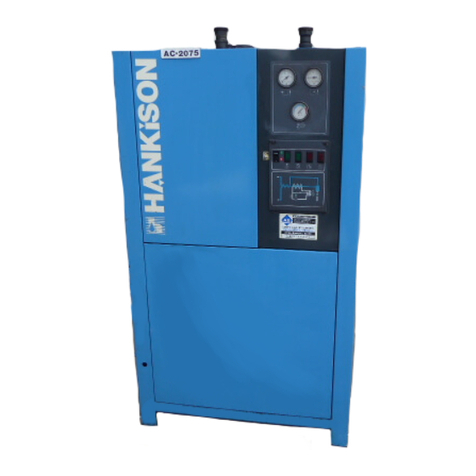
HANKISON
HANKISON PR500 User manual
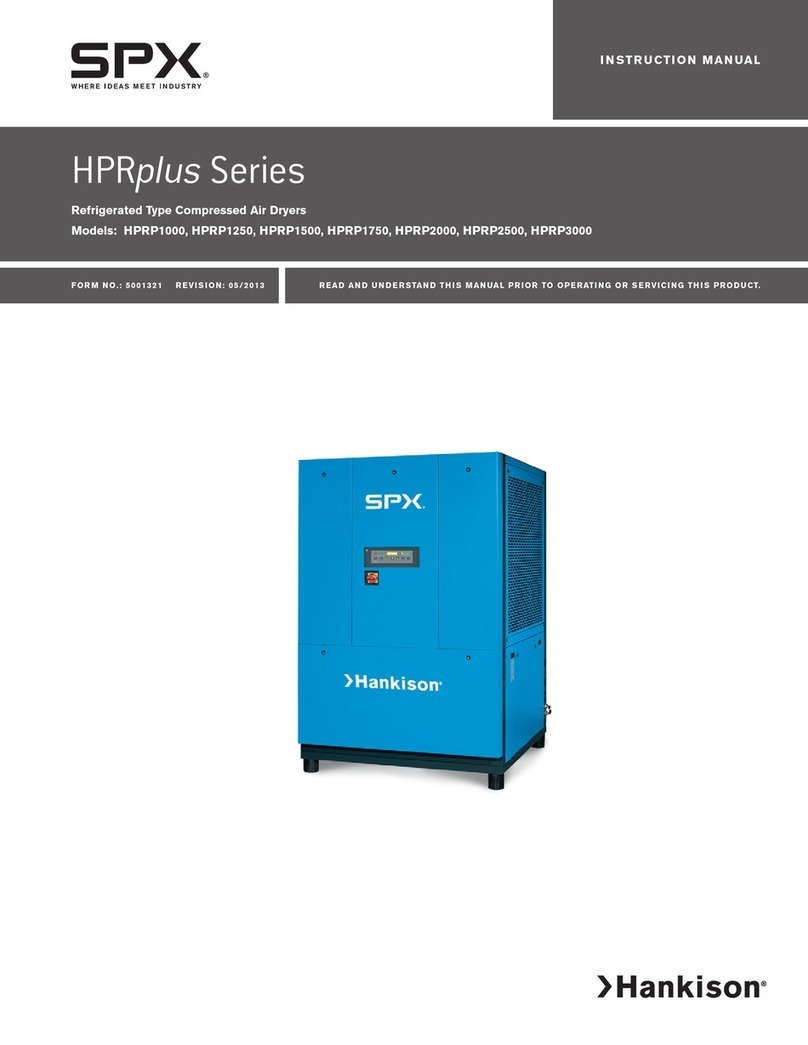
HANKISON
HANKISON HPRplus HPRP1000 User manual

HANKISON
HANKISON H Series User manual

HANKISON
HANKISON HPRD 0.50-500 User manual

HANKISON
HANKISON HPET Series User manual

HANKISON
HANKISON HPRP 25 User manual

HANKISON
HANKISON HBP Series User manual
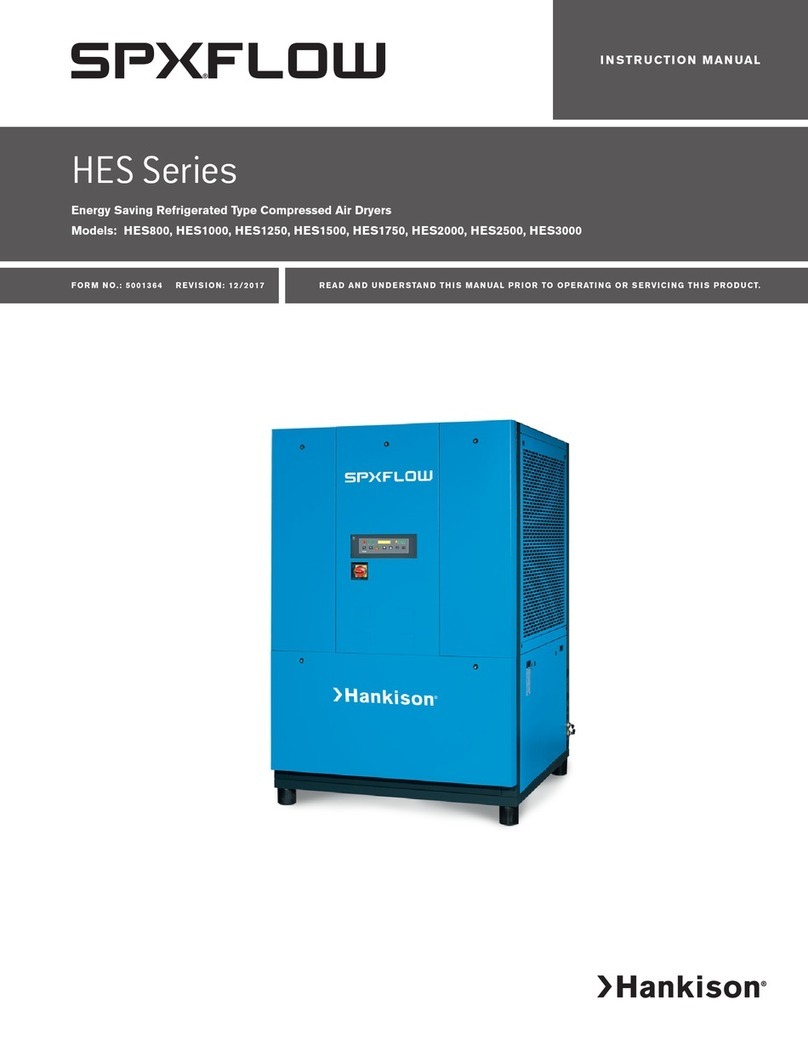
HANKISON
HANKISON SPX FLOW HES Series User manual
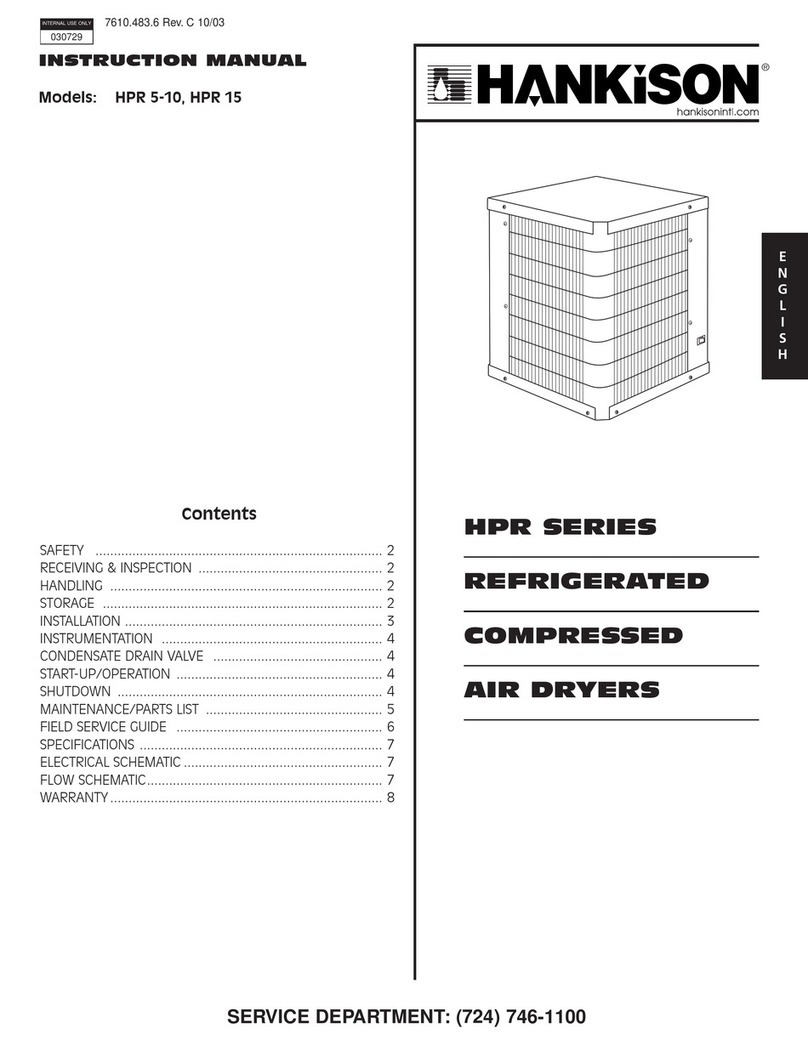
HANKISON
HANKISON HPR Series User manual
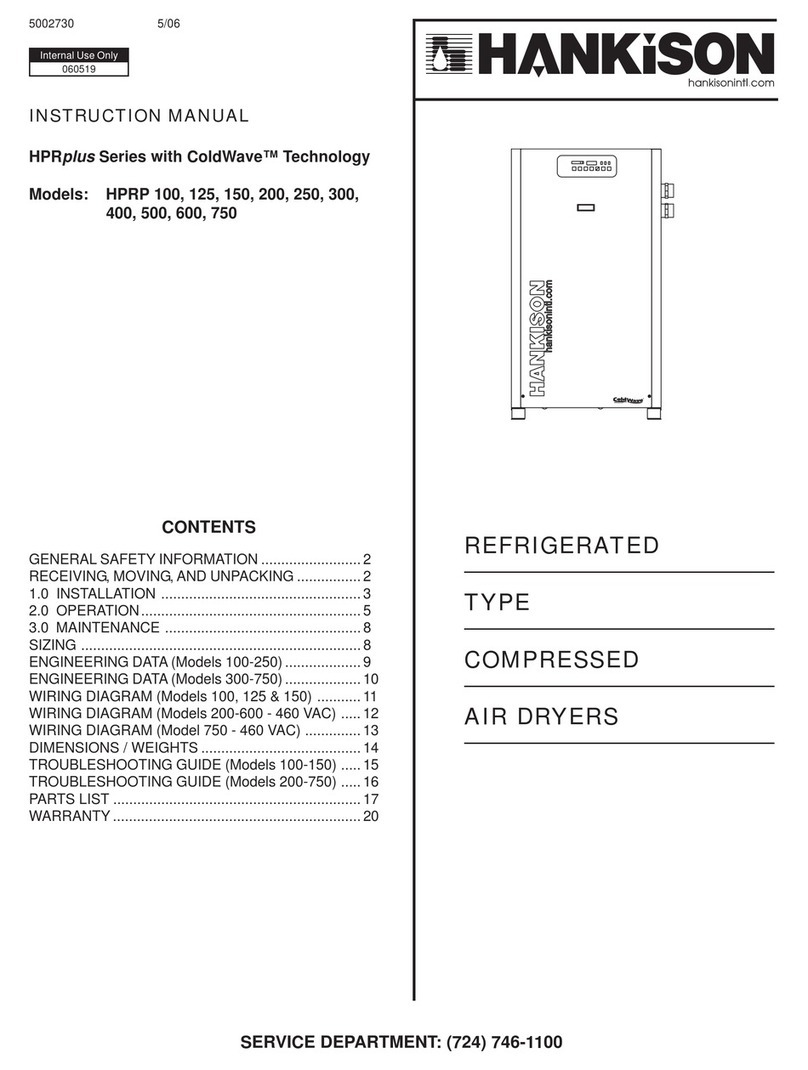
HANKISON
HANKISON HPRplus Series User manual

